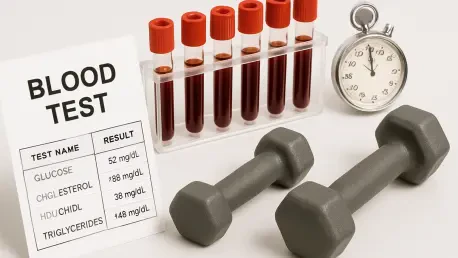Imagine a world where a simple blood draw could reveal not just health risks, but also how physically fit an aging individual is, offering a window into their overall vitality and providing a groundbreaking tool for personalized care. For many older adults, maintaining mobility and strength is a daily challenge, with statistics showing that nearly 30% of those over 65 experience significant declines in physical function. This startling reality underscores a pressing need for innovative tools to assess and support active aging. A groundbreaking approach using blood tests to predict physical fitness has emerged as a game-changer, providing insights into metabolic health that go beyond traditional fitness assessments. This guide delves into best practices for leveraging this molecular profiling to promote healthier aging, exploring methodologies, key findings, and actionable implications for individuals and healthcare providers.
Introduction to Molecular Markers and Active Aging
The concept of using blood tests to gauge physical fitness in older adults represents a significant leap forward in health monitoring. Pioneering research from leading institutions has shown that specific molecular markers in the blood can reflect an individual’s level of active aging, offering a non-invasive way to track vitality. This approach is rooted in the understanding that metabolic changes driven by physical activity can be measured, providing a clearer picture of underlying health.
Active aging is a critical focus in modern healthcare, as it directly impacts quality of life and independence for seniors. Identifying molecular signatures through blood analysis helps bridge the gap between observable physical capabilities and internal biological processes. This guide outlines the essential practices for adopting this innovative method, covering how the research was conducted, the most impactful discoveries, and how these findings can transform health strategies for aging populations.
The importance of this tool lies in its potential to personalize interventions and prevent age-related decline before it becomes severe. By focusing on molecular markers, healthcare providers can move toward precision health, tailoring recommendations to individual needs. Key areas of discussion include the study’s approach, significant outcomes, practical health implications, and future directions for this cutting-edge technology.
The Importance of Measuring Physical Fitness Through Blood Tests
Assessing physical fitness via blood-based molecular signatures is vital for older adults, particularly in addressing mobility loss and the onset of chronic conditions. Traditional methods, such as physical performance tests, often fail to capture the full spectrum of health, missing subtle metabolic shifts that signal decline. A blood test offers a deeper look, revealing how well the body adapts to activity at a cellular level, which is crucial for maintaining independence in later years.
This non-invasive approach brings several advantages, including the ability to monitor health without subjecting individuals to strenuous physical evaluations. It also provides personalized insights, allowing for early interventions that can slow or prevent deterioration. For instance, detecting low activity levels through blood markers could prompt lifestyle changes or medical support long before physical limitations become evident.
Moreover, this method connects observable fitness with underlying metabolic health, offering a comprehensive view of well-being. It empowers both individuals and clinicians to make informed decisions based on concrete data rather than subjective observations. Embracing this practice can redefine how aging is managed, shifting the focus from reactive treatment to proactive prevention.
Key Findings and Methodologies Behind the Blood Test
The development of a blood test to predict physical fitness in older adults is grounded in rigorous research that combines physical assessments with advanced molecular analysis. This innovative approach has yielded insights into how specific blood markers correlate with activity levels, providing a reliable indicator of health. By integrating diverse methodologies, the study offers a robust framework for understanding aging at a biochemical level.
A key aspect of this research is the use of sophisticated tools to analyze blood samples alongside fitness metrics, ensuring accuracy and relevance. The findings demonstrate that metabolic profiles can mirror physical performance, opening new avenues for health monitoring. This section explores the critical components of the study, breaking down complex processes into practical takeaways for broader application.
Understanding these methodologies is essential for adopting best practices in health assessments for seniors. The research not only validates the use of blood tests but also highlights specific markers that are most indicative of fitness. This evidence-based foundation is crucial for integrating such tests into routine care, ensuring they are both effective and accessible.
Developing the Body Activity Index (BAI) and Metabolomics Index
One of the cornerstone practices in this research involves creating the Body Activity Index (BAI), a composite measure derived from fitness tests such as walking distance, handgrip strength, and balance evaluations. This index encapsulates various dimensions of physical capability, providing a standardized way to quantify activity levels. Alongside BAI, the Metabolomics Index was developed using concentrations of blood metabolites, offering a parallel biochemical perspective.
A strong correlation between these two indices has been established, proving that blood tests can accurately reflect physical fitness. This connection is a critical validation, demonstrating that metabolic markers are not just abstract data points but meaningful indicators of real-world health. Incorporating this dual-index approach into health assessments can enhance the precision of fitness evaluations for older adults.
To illustrate, active seniors with high BAI scores consistently showed distinct blood metabolite profiles that aligned with their physical performance. This real-world correlation underscores the practical value of combining fitness and molecular data. Adopting this practice ensures that assessments are grounded in tangible outcomes, making them more actionable for healthcare planning.
Identifying Key Biomarkers Using Machine Learning
Another best practice emerging from this research is the application of machine learning to pinpoint key blood metabolites that predict physical activity levels. Advanced algorithms analyzed vast datasets to identify significant markers such as aspartate, proline, and others, with aspartate emerging as the most dominant indicator. This data-driven approach ensures that only the most relevant biomarkers are prioritized for health monitoring.
The precision of machine learning models allows for distinguishing between active and less-active individuals with high accuracy, providing a reliable tool for clinicians. Focusing on biomarkers like aspartate, which showed exceptional predictive power, can streamline blood tests to focus on the most impactful metrics. This targeted method reduces complexity while maximizing the utility of results for personalized care.
An example from the study revealed that aspartate levels were markedly different between active and sedentary participants, clearly delineating fitness categories. This finding highlights the importance of integrating computational tools into biomarker identification, ensuring that health assessments are both efficient and scientifically sound. Such practices can guide the development of focused interventions based on individual metabolic profiles.
Understanding Metabolic Mechanisms with Network Modeling
A further best practice involves using network modeling to map biochemical interactions and uncover the mechanisms behind metabolic changes linked to fitness. Tools like COVRECON have been instrumental in identifying enzymes such as aspartate aminotransferase (AST) and alanine aminotransferase (ALT) as central to metabolic flexibility. This approach provides a deeper understanding of how physical activity influences internal processes.
These enzymes, often associated with liver function, play a significant role in how the body adapts metabolically in active individuals. Network modeling reveals dynamic fluctuations in enzyme activity over time, particularly in those who maintain regular exercise. Implementing this analytical method in research and clinical settings can enhance the comprehension of metabolic health, informing better health strategies.
Observations from the study showed that active adults exhibited greater enzyme variability over a six-month period compared to their less-active peers, indicating adaptive metabolic responses. This insight emphasizes the value of tracking such changes through blood tests to assess the impact of lifestyle on health. Adopting network modeling as a standard practice can provide a comprehensive view of aging, linking activity to biological resilience.
Implications for Health and Broader Applications
The implications of using blood tests to measure physical fitness extend far beyond mobility, touching on broader aspects of health such as cognitive well-being. Research suggests a connection between exercise, aspartate metabolism, and brain health, indicating that physical activity could help mitigate risks of conditions like dementia. Incorporating this knowledge into health practices can foster a more holistic approach to aging.
Personalized health strategies stand to benefit immensely from this molecular profiling, allowing for tailored interventions based on individual blood markers. For aging individuals, healthcare providers, and researchers, this tool offers a way to monitor progress and adjust plans proactively. Best practices here include ensuring accessibility of such tests and integrating them into routine checkups for maximum impact.
Looking ahead, molecular profiling holds the potential to revolutionize aging research and precision health. It can inform public health initiatives by identifying at-risk populations early and promoting preventive measures. Encouraging the adoption of this practice involves collaboration between medical professionals and technology developers to refine and scale these blood-based assessments for widespread use.
Final Thoughts
Reflecting on the insights gained, it becomes evident that blood tests offer a transformative way to assess physical fitness in older adults, providing a clear window into metabolic health. The journey through methodologies like the Body Activity Index, machine learning for biomarker identification, and network modeling revealed a path to more precise and personalized care. These practices proved instrumental in decoding the complex interplay between activity and aging at a molecular level.
Moving forward, the focus should shift to making these blood tests a standard part of health assessments, ensuring they are accessible to diverse populations. Collaborations between healthcare systems and research institutions can help refine testing protocols and train professionals in interpreting molecular data. This step is crucial for translating scientific advancements into everyday benefits for seniors.
Additionally, future efforts should explore how these findings can integrate with digital health platforms to provide real-time feedback to individuals. Empowering older adults with tools to track their fitness through simple blood markers can inspire sustained lifestyle changes. This proactive approach marks a significant stride toward enhancing quality of life, setting a foundation for healthier aging across generations.









